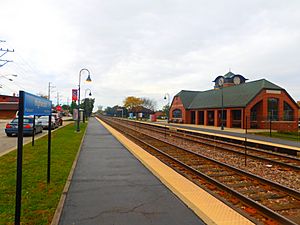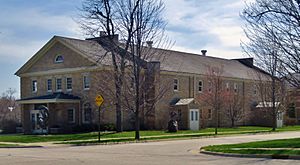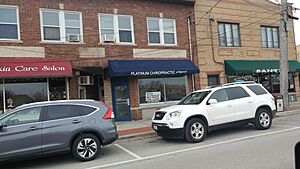Highwood, Illinois facts for kids
Quick facts for kids
Highwood, Illinois
|
|
|---|---|
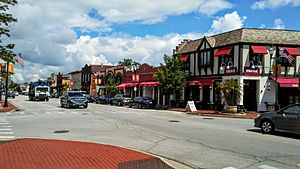
Downtown Highwood
|
|

Location in Lake County, Illinois
|
|
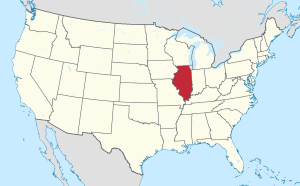
Location of Illinois in the United States
|
|
| Country | United States |
| State | Illinois |
| County | Lake |
| Area | |
| • Total | 0.72 sq mi (1.86 km2) |
| • Land | 0.72 sq mi (1.86 km2) |
| • Water | 0.00 sq mi (0.00 km2) |
| Population
(2020)
|
|
| • Total | 5,074 |
| • Density | 7,047.22/sq mi (2,721.29/km2) |
| Time zone | UTC-6 (CST) |
| • Summer (DST) | UTC-5 (CDT) |
| ZIP Code(s) |
60040
|
| Area code(s) | 847 |
| FIPS code | 17-34865 |
| Wikimedia Commons | Highwood, Illinois |
Highwood is a North Shore suburb of Chicago in Moraine Township, Lake County, Illinois, United States. As of the 2020 census, the population was 5,074. It is known for its entertainment, restaurants, bars, and festivals.
Contents
Geography
Highwood is located in southeastern Lake County at 42°12′19″N 87°48′44″W / 42.205357°N 87.812345°W, on a ridge 100 feet (30 m) above the elevation of Lake Michigan.
According to the 2010 census, Highwood has a total area of 0.71 square miles (1.84 km2), all land.
The city is located next to Highland Park and Fort Sheridan, and south of the Fort Sheridan Forest Preserve.
History
Originally, the land was owned by the Potawatomi until it was ceded to the United States through the 1833 Treaty of Chicago. The first non-Native American settled in the town in 1846. In 1851 Highwood became the headquarter location of the Chicago North Shore and Milwaukee Railroad, which ran parallel to the Chicago and North Western Railway, and is known today as Metra's Union Pacific / North Line. Thomas Curley suggested the name High Woods because the land was the highest ground between Chicago and Milwaukee and was covered with trees.
In 1886 civil and labor unrest in Chicago eventually led to the Haymarket Riot. Chicago businessmen felt that having a military presence near the city would help alleviate tensions within the city and on November 8, 1887 purchased Camp Highwood. This land would come to host members of the Sixth Infantry Regiment. On February 27, 1888 Camp Highwood was officially named Fort Sheridan in honor of General Philip Sheridan for his ability to maintain order after the Chicago Fire of 1871.
Highwood provided several business and employment opportunities and following the fire, many of those who lost their home and a wave of immigrants settled into the town. Highwood can also give credit to much of their economic success to the Chicago and Milwaukee Electric Railway. However, with increased transportation it also caused a sudden rise in gambling dens and illegal "blind-pig" taverns which catered to off duty soldiers. This eventually provoked federal authorities to enact the "Highwood Quadrangle" which prohibited the sale of liquor within 1 1/8th miles of the army base.
Fort Sheridan acted as an entertainment center for the town and on July 18, 1888 the trustees voted to change the name from Highwood to the Village of Fort Sheridan to capitalize on its military glamour. However, 8 years later in 1894 the name was changed back to Highwood due to resident frustration and confusion with postal misrouting. The city's business district became filled with bars and taverns which led Theodore Roosevelt to call the city "one of the toughest towns in America".
In the 1920s a large number of Northern Italian immigrants (originally from Modena) moved to Highwood, many from Dalzell, Illinois, a coal mining town in Bureau County, to seek jobs. The national prohibition of alcohol at the time also attracted bootleggers who smuggled large quantities of liquor into the city. The fight to prevent Highwood from being known as a whisky den largely brought the community together.
Following the start of World War II Fort Sheridan was used as an active training ground. By the end of the war Highwood had experienced another wave of immigration, this time a majority of immigrants coming from Europe and Mexico. Since then Highwood's business have continued to flourish and the city has become the destination for North Shore dining and nightlife. The city frequently hosts festivals for residents known as Celebrate Highwood which is hosted by the city chambers.
Transportation
The main highway to Highwood is U.S. Route 41, which connects Chicago to Milwaukee. Commuter rail is available at two different Metra stations locations within the city (Fort Sheridan and Highwood). Highwood is also located near the Highland Park and Lake Forest stations which all located on the Union Pacific North Line which begins in Kenosha and ends in the downtown area of Chicago at Ogilvie Transportation Center.
Pace provides bus service on Route 472 connecting Highwood to Highland Park, Fort Sheridan, and other destinations.
The city is approximately 22 miles (35 km) from O'Hare International Airport and 31 miles (50 km) from Midway International Airport.
Schools
Highwood residents are served by North Shore School District 112 and Township High School District 113. The majority of Highwood's children attend Oak Terrace School for Kindergarten through fifth grade, Northwood Junior High School for sixth through eighth grade, and Highland Park High School for grades nine through twelve.
St. James School was a private Catholic school located in Highwood, but closed in 2015 due to a lack of funding and low enrollment.
Recreation
The Don Skrinar Recreation Center is a public recreation facility located near downtown Highwood. The city is also a host to the Midwest Young Artists Conservatory and The Performer's School. The Fine Art Studio of ROTBLATT-AMRANY which is owned by Julie Rotblatt Amrany is located within the old village of Fort Sheridan.
Demographics
| Historical population | |||
|---|---|---|---|
| Census | Pop. | %± | |
| 1890 | 451 | — | |
| 1900 | 1,575 | 249.2% | |
| 1910 | 1,219 | −22.6% | |
| 1920 | 1,446 | 18.6% | |
| 1930 | 3,590 | 148.3% | |
| 1940 | 3,707 | 3.3% | |
| 1950 | 3,813 | 2.9% | |
| 1960 | 4,499 | 18.0% | |
| 1970 | 4,973 | 10.5% | |
| 1980 | 5,455 | 9.7% | |
| 1990 | 5,331 | −2.3% | |
| 2000 | 4,143 | −22.3% | |
| 2010 | 5,405 | 30.5% | |
| 2020 | 5,074 | −6.1% | |
| U.S. Decennial Census 2010 2020 |
|||
2020 census
| Race / Ethnicity (NH = Non-Hispanic) | Pop 2000 | Pop 2010 | Pop 2020 | % 2010 | % 2010 | % 2020 |
|---|---|---|---|---|---|---|
| White alone (NH) | 2,347 | 2,079 | 2,071 | 56.65% | 38.46% | 40.82% |
| Black or African American alone (NH) | 79 | 72 | 110 | 1.91% | 1.33% | 2.17% |
| Native American or Alaska Native alone (NH) | 9 | 3 | 8 | 0.22% | 0.06% | 0.16% |
| Asian alone (NH) | 86 | 114 | 137 | 2.08% | 2.11% | 2.70% |
| Native Hawaiian or Pacific Islander alone (NH) | 2 | 1 | 0 | 0.05% | 0.02% | 0.00% |
| Other race alone (NH) | 9 | 16 | 23 | 0.22% | 0.30% | 0.45% |
| Mixed race or Multiracial (NH) | 27 | 46 | 127 | 0.65% | 0.85% | 2.50% |
| Hispanic or Latino (any race) | 1,584 | 3,074 | 2,598 | 38.23% | 56.87% | 51.20% |
| Total | 4,143 | 5,405 | 5,074 | 100.00% | 100.00% | 100.00% |
2010 census
At the 2010 census, Highwood's resident population was 5,405. The median resident age was 32.8.
The racial makeup of the city was 69.64% White (38.5% Non-Hispanic White), 1.54% Black or African American, 2.24% Asian, 0.31% Native American, 0.02% Pacific Islander, 22.92% of some other race and 3.33% of two or more races. 56.87% were Hispanic or Latino (of any race).
Architecture
Highwood was settled in 1887 and was largely developed before the post-World War II building boom that led to much of the suburban development that characterizes Lake County. Therefore, the city has a large collection of pre-war residential and commercial structures that reflect the architecture popular during that period, including neo-classical, Italianate, and arts and crafts bungalow styles. Also common in the business district are brick commercial "store front" structures with commercial businesses on the ground floor and residential apartments above.
Notable people
- Frank Bernardi, National Football League defensive back (1955–1960)
- Scott Drury, member of the Illinois House of Representatives (2013–2019)
- Lowell B. Komie, lawyer and writer
- Francis Joseph Magner, prelate of Catholic church; served as Bishop of Marquette (1941–1947)
- Settimio Fernando "Terry" Terracina , Light Heavy-Weight Boxing Champion of Italy 1936 to 1939. Owner of The Rainbow (1949 to 1968) and La Lira(1968 to 1974) Born in Rome: January 11, 1917 Died February 10,1985, Buried at Shalom Memorial Park.
See also
 In Spanish: Highwood (Illinois) para niños
In Spanish: Highwood (Illinois) para niños


